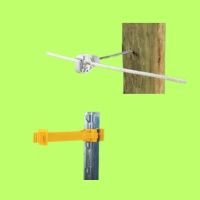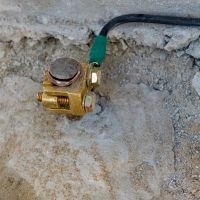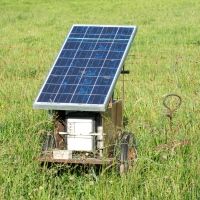Remember that it’s not wise & legal to electrify a wire fence. According to Standard International Electrotechnical rules EU regulation IEC 60335-2-76, Annex BB. 2002, it’s illegal to directly electrify a barbed wire fence.
Here are some reasons:
- The sharp spikes on barbed wires are already quite dangerous and can easily rip clothes and flesh. The sudden reaction to shock may cause serious injury if the barbed wire fence is electrified.
- Also, the barbed wires won’t free a human or animal entangled in them. Constant shock pulses will penetrate the body continuously, resulting in burns, psychological disorders, and even death.
- Also, barbed wires could be installed on metal posts or they may be touching metal objects. It will cause a short circuit & make the fence power leak into the ground, making it useless.
What is the right way to electrify your barbed wire fences?
To keep animals from pushing against the barbed wire fence & prevent the hustle of stretching wires & posts we can install an electric fence offset(at a little distance) to the barbed fence. This process is called retrofitting.
It helps you keep your animals from rubbing the barbed wire fence(loosening), getting injured, and keep your fence straight & stretched. However, we’ve to make sure that both fences don’t touch each other.
How to electrify a barbed wire fence?
Instead of directly electrifying barbed wires, it’s safe to install electric fence wires a few inches away(offset). For this purpose, you can install fence wires either on the same fence posts using extended post insulators. Or you can install separate fence posts for electric fence wires.
Make sure that both fences are stretched, don’t touch & should be at least 6 inches away from each other. This method will keep your barbed wire fence & animals safe.
Follow the step-by-step guide below:
Step 1: Measure the area to be covered
First of all, decide the area around the chain link you want to cover. Use a measuring tape or GPS to calculate the length of the area.
After that decide on the number of strands. It depends on which animals you’ve kept.
If you’ve kept goats, 3-4 live strands would be enough.
For cows & donkeys, you can install 2-3 strands, 2 feet apart from each other.
Similarly, you can install 3 strands that are enough for dogs, placed one foot apart.
Deciding the number of strands will help you know the length of fence wires required. Multiply the number of strands by the total length of the area you’ve measured. This is the total wire required for installing fence strands.
Step 2: Choose & install fence post insulators
You can either install electric fence wires on the same posts on which the barbed wire fence is installed. For this purpose, extended(offset) post insulators are ideal as they extend a few inches from the post body & can keep the electric fence wires away from the barbed fence wires. Try to choose insulators with the maximum length available.
Also, make sure to choose insulators according to the shape & type of post. Extended post insulators are available for T-posts, U-posts & wood posts. T-post & U-post insulators get clipped over the post’s body. While the wood post insulators get drilled into the wood post.
After you’ve got the right post insulators, install them on your fence post at the exact distance.
Make sure that one of the fence strands will be installed at the nose/face height.
Remember that extended post insulators are also made of plastic & due to extended length, they can easily break.
Hence for better strength, you can also install separate fence posts in front of the welded wire fence & install fence strands on them.
Step 3: Install fence wires
After you’ve installed fence insulators. It’s time to install electric fence wires. Start from a corner post & tie off the fence wire at the start using corner post insulators.
Continue & hook the fence wire into each insulator in the row. After one strand is complete continue to the second strand.
If you’ve to cover a large area, it’s better to install fence wires in parallel. For this, you’ve to install all strands separately & then they are interconnected at multiple points.
It helps reduce resistance by offering multiple paths to current hence ideal for large area fencing. However, to cover small areas, series (continuous) fence wiring is helpful as it’s easy to install.
To terminate fence wire use end post insulators as they are sturdy & bear more load.
Step 4: Install grounding for the electric fence
After fence wires are installed, it’s time to install electric fence grounding.
Grounding is the most sensitive & necessary port of electric fence, so take care while choosing products & installation. Follow the tips below:
Use high-quality galvanized steel rods for grounding.
Install at least 3 feet of ground rod per joule output of the fence. For example: For a 10-joule fence charger, use 10X3=30 feet of ground rods.
Each ground rod should be 6-8 feet long.
Install the first ground rod within 10 feet of the fence charger.
Install ground rods 10 feet from each other.
Connect all ground rods using galvanized ground clamps & high-quality instated wire.
If the ground is dry install more rods. Pour water near the rods to increase current conductivity in the soil.
Cut off any excessive weed that may touch the ground rods & fence wires.
Step 5: Setup fence charger
Hang the energizer under a shade in a dry & airy location. Use highly conductive & insulated wires to connect the energizer.
Connect the live terminal of the energizer to any of the live fence strands. Similarly connect the energizer’s ground terminal to the nearest ground rod.
Securely wind the wire around the terminal & tighten the screw. Make sure that every connection is strong. Turn on the energizer.
It’s also necessary to test the fence after installation is complete. We can use any type of fence tester, multimeter, or voltmeter.
Usually, energizers have different voltage ranges but most of them output more than 5000. If the voltage is quite low, check for short circuits in the fence.
Conclusion:
Electrifying a barbed fence wire imposes serious dangers to passers-by. Reaction to sudden shock can result in severe injuries & even death if someone gets entangled.
That’s why it’s a better option to install electric fence wires around the barbed wire fence, at some distance(6 inch-1 feet).
To install an electric fence around the barbed fence wire, follow the complete guide above.
If you still have any queries, ask us in the comments below.

